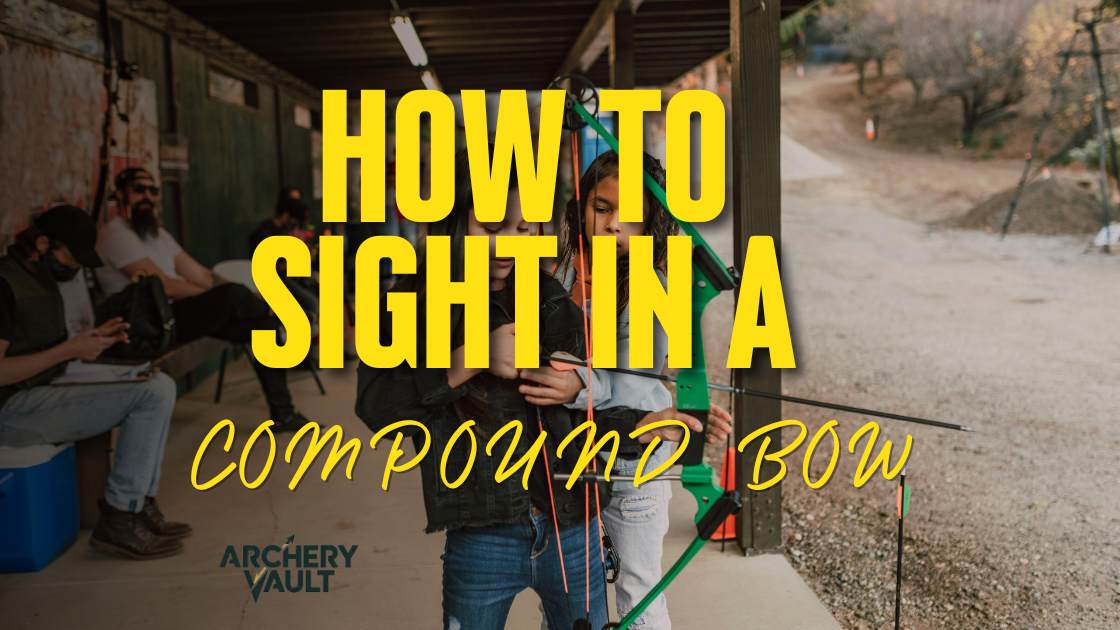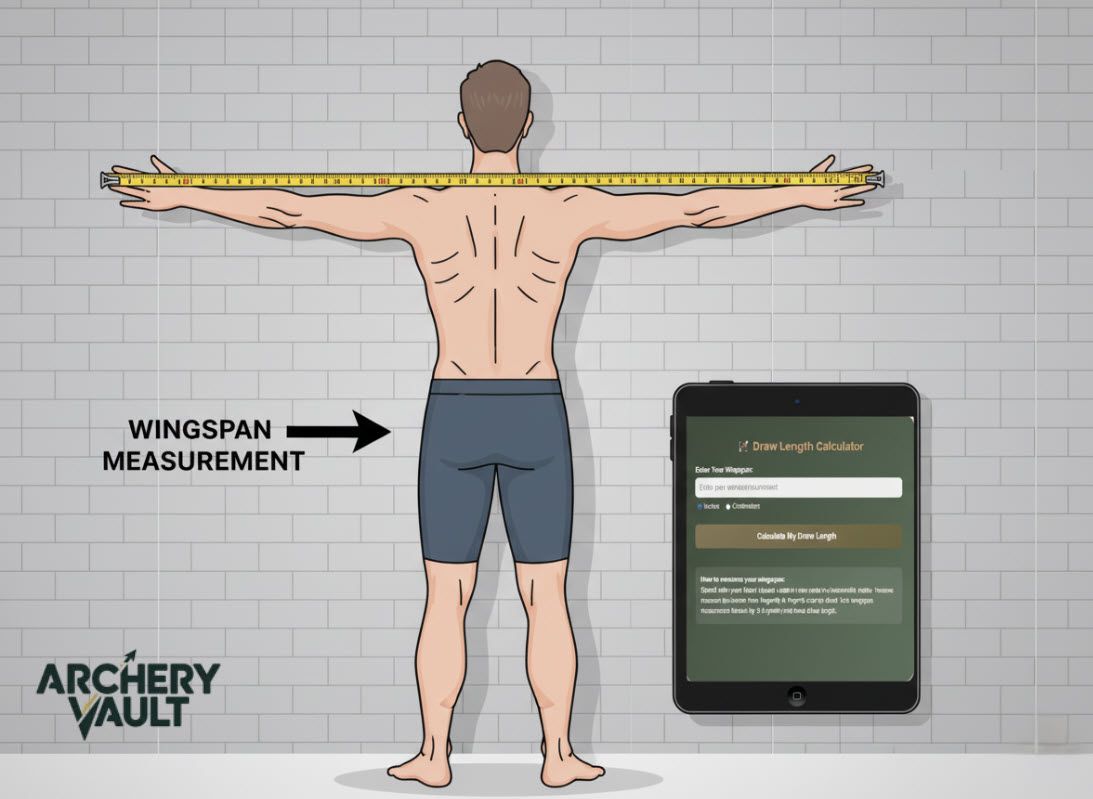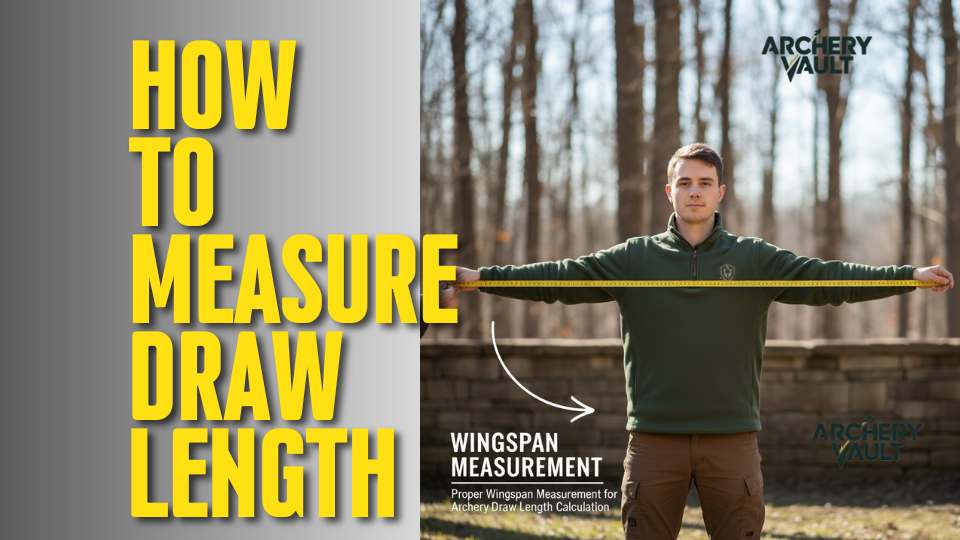Getting your bow sight dialed in isn’t complicated, but I’ve watched countless archers waste hours at the range because nobody showed them the right method. Whether you just mounted a new sight or you’re preparing for hunting season, the process is the same – and you can knock it out in about 30 minutes if you follow these 3 steps correctly.
This guide walks you through the exact process I use to sight in every bow. No guesswork, no shooting 200 arrows hoping things improve. Just a straightforward method that gets your pins accurate and keeps them that way.
What You Need Before Sighting In Your Bow
Before you shoot a single arrow, your equipment needs to be ready.
Check Your Sight Mounting
Make sure your sight is mounted solidly – loose screws are the number one reason people struggle with consistency. The sight housing shouldn’t wiggle when you pull on it.
Verify Peep Alignment
Your peep sight needs proper alignment in your bow string. When you draw back, you should naturally look through the peep without tilting your head or torquing the string. If your peep isn’t aligned, stop and fix it. Trying to sight in a bow with a misaligned peep is incredibly frustrating.
Ensure Arrows Fly Straight
Your arrows need to be flying straight before you start adjusting pins. You don’t need perfect paper tears, but arrows shouldn’t be fishtailing downrange. If you’re seeing wild arrow flight, you’ve got a tuning problem, not a sight problem. Get that sorted first or you’ll be chasing your tail.
Pick the Right Conditions
Pick a calm day. Wind makes this process miserable and you’ll spend the whole time second-guessing whether that shot was your fault or a gust pushed it.
Understanding How Pin Sights Work on Compound Bows
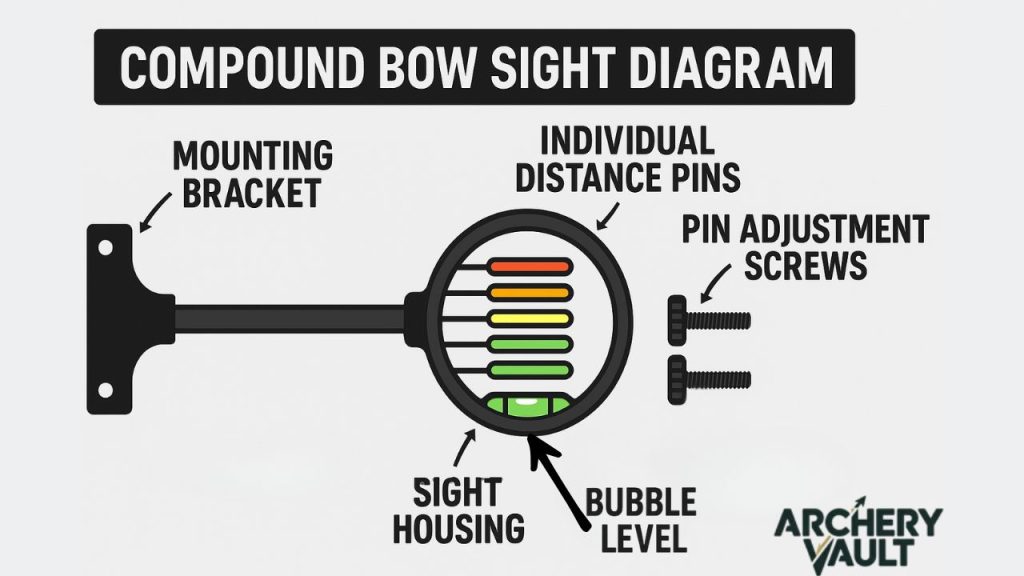
Most compound bows use multi-pin sights – typically a 3 pin or 5 pin setup. The top pin is your closest distance (usually 20 yards), and each pin below represents a farther yardage.
Here’s what trips people up: when your arrow hits low, you move the pin down. When it hits left, move the pin left.
This feels backwards because people think “arrow hit low, so I need to aim higher, so move the pin up.”
Nope. Follow your arrow. The pin needs to move in the direction your arrow impacted. I’ve said “chase the arrow” about 500 times, and it’s still the easiest way to remember.
The sight housing moves independently from individual pins. You’ll adjust the housing for major changes and each pin for fine-tuning specific distances.
Step 1: Set Your First Pin at 20 Yards
Start at 20 yards. Not 10, not 30 – twenty yards. Close enough to see what’s happening but far enough that small form issues show up.
Set your top pin somewhere in the middle of your sight housing’s adjustment range before your first shot. Don’t crank it all the way to the top or bottom. You need room to adjust in both directions. Draw back, settle your anchor point (corner of mouth, consistently, every time), and aim dead center. Shoot three arrows. Not one – shoot three with identical form.
Walk up and look at your group. They should be somewhat clustered. If they’re scattered everywhere, you’ve got a consistency problem with your shooting form. Once you have a reasonable group, measure where the center is relative to your aim point.
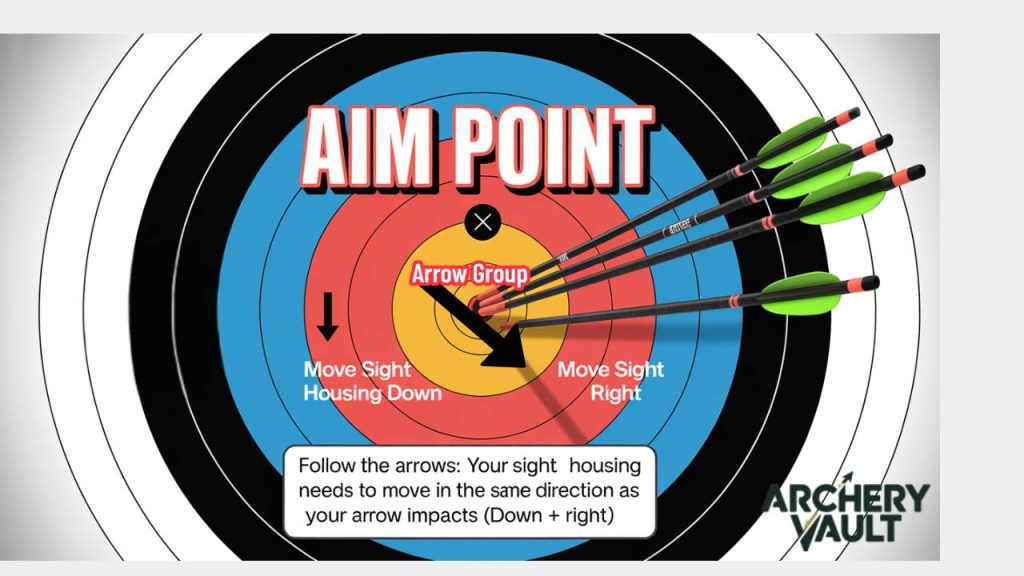
Let’s say your arrows hit 6 inches low and 3 inches right. You need to move your entire sight housing down and right. Loosen the mounting screws slightly, slide it in the direction your arrows hit, then tighten everything back down. Shoot three more arrows.
Keep repeating this process until your group is roughly centered on target at 20 yards. Once you’re hitting within a few inches of center, it’s time for fine adjustments.
Step 2: Fine-Tune Your 20-Yard Pin
Now we’re adjusting just that individual pin, not the whole sight housing. Your sight has tiny screws or dials that move each pin left, right, up, and down.
Shoot another three-arrow group at 20 yards. Look at where the center of that group is. If it’s slightly left, adjust the pin left by a small amount – usually a quarter turn or less. If arrows are hitting high, move the pin up slightly. Remember: chase the arrow.
Make small adjustments. Shoot three arrows. Check your impact. Adjust again if needed. I’ve watched archers overcorrect, then overcorrect the other direction, then get frustrated bouncing all over. Tiny adjustments, consistent form, three-shot groups. That’s the method.
Once you’re consistently hitting within an inch or two of your aim point at 20 yards, your first pin is set. Don’t obsess over millimeter perfection. Bowhunting accuracy requirements are different from target archery.
Step 3: Setting Your Remaining Pins

With your 20-yard pin dialed in, move back to 30 yards. Use your second pin and shoot a three-arrow group. That pin isn’t set yet, so arrows will hit somewhere random. Follow the same process – adjust that pin to chase your arrows. If they hit low and right, move that pin down and right. Keep shooting three-arrow groups and adjusting until you’re centered at 30 yards.
Once your 30 yards pin is set, step back to 40 yards and repeat with your third pin. The process never changes: shoot three arrows, adjust the pin to chase the impact point, repeat until centered.
At longer ranges like 40 yards and beyond, tiny adjustment changes make bigger differences downrange. A quarter-turn that moved your impact an inch at 20 yards can move it three inches at 40. Make even smaller adjustments at distance.
Common Mistakes Bowhunters Make
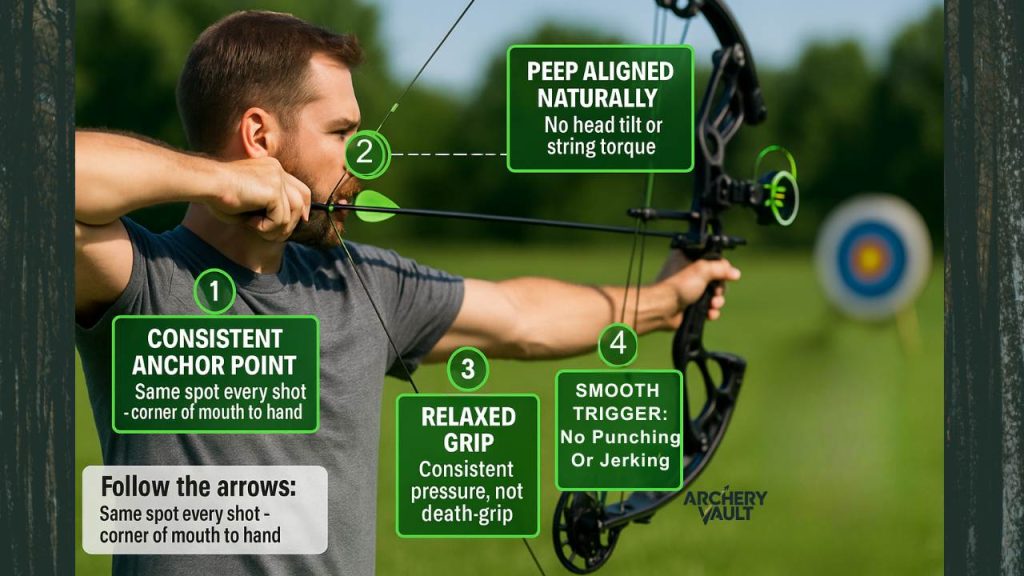
Inconsistent Shooting Form
The biggest mistake is inconsistent shooting form. If you’re all over the place with your anchor point, grip pressure, or release, no amount of sight adjustment will fix that. Every shot needs to be identical. Same anchor, same grip, same smooth release. When someone tells me “my sight won’t stay zeroed,” it’s usually a form problem.
Over-Adjusting Too Quickly
Second biggest: adjusting too much, too fast. Make one small change, then shoot to verify it. Don’t touch three different adjustment screws and wonder which one helped.
Adjusting the Wrong Component
Moving the wrong thing is another classic error. If you need to move your whole group, adjust the sight housing. Individual pin adjustments are for fine-tuning specific distances after your housing is positioned correctly.
Starting with Broadheads
Some archers try to sight in with broadheads right from the start. Bad idea. Get your bow sighted in with field points first – they fly more consistently and they’re cheaper. Once everything is dialed in with field points, then test your broadheads and make minor adjustments if needed.
When to Re-Sight Your Bow
Your sight doesn’t need constant adjustment if everything is set up correctly, but certain situations require verification.
Any time you make changes to your bow setup – new string, different arrows, arrow rest adjustment – verify your sight is still accurate. Sometimes these changes affect nothing. Sometimes they shift your impact. A quick range trip beats discovering problems on a hunt.
If you travel with your bow, especially flying with it, check your sight before you hunt. I’ve seen mounting screws loosen from vibration.
Most bowhunters check their sight at the start of each hunting season even if nothing changed. Strings settle over time, and your form can drift during the off-season. Shoot at all your pin distances and verify each one is still accurate.
If you’re consistently hitting different than usual and haven’t changed anything on your bow, look at your form first before cranking on adjustment screws. Form issues are way more common than sights mysteriously shifting.
Quick Tips for Getting Your Bow Accurate
Practice in Realistic Positions
Practice from the same shooting position you’ll hunt from. If you’re a treestand hunter, practice from elevation. Angles change things. If you shoot from a ground blind, practice sitting down with your bow positioned like it will be during a hunt.
Test After Temperature Changes
Verify your sight after the first cold morning. Temperature affects bow performance slightly. I’ve had bows hit a bit different on a 20-degree morning compared to the 70-degree afternoon when I sighted them in.
Document Your Settings
Mark your sight tape or write down your settings. If you bump something out of adjustment, you want to know where it was. Some sights let you lock pins once they’re set – use that feature.
Know Your Effective Range
Don’t obsess over perfection. This is bowhunting equipment, not a benchrest rifle. If you can consistently hit a 6-inch circle at your maximum intended shooting distance, you’re accurate enough to hunt ethically and make clean shots on deer.
Key Takeaways for Sighting In Your Bow
- Start at 20 yards and work back to longer distances – don’t jump around between yardages
- Always move your pin in the direction your arrow hit – chase the arrow every time
- Make small adjustments and verify with three-shot groups – don’t overcorrect
- Adjust the sight housing for major changes, individual pins for fine-tuning – knowing which to move saves time
- Shoot with consistent form – anchor point, grip, and release must be identical every shot
- Get your bow tuned before obsessing over sight adjustments – if arrows aren’t flying straight, the sight isn’t your problem
- Verify your sight before hunting season and after equipment changes – takes 30 minutes and prevents bad surprises
- Practice from realistic hunting positions – flat range work might need adjustment from a treestand
The whole process really does come down to those 3 steps: set your close pin, fine-tune it, then repeat for each additional distance. Follow that method with consistent shooting form and you’ll have your sight dialed in quickly.

